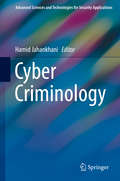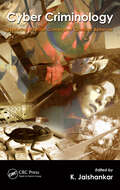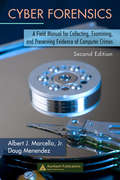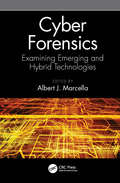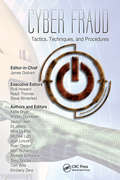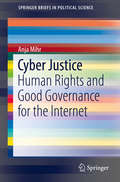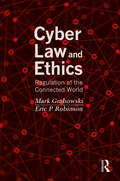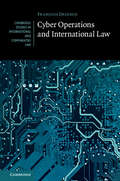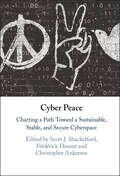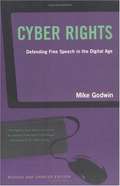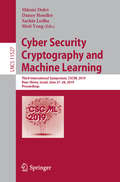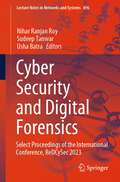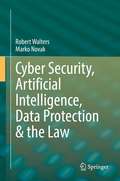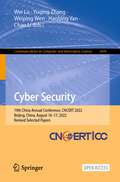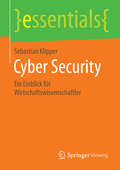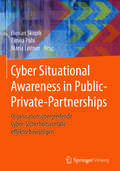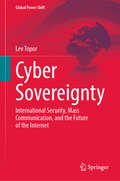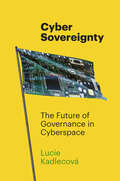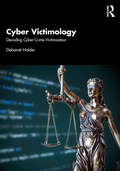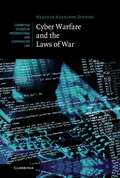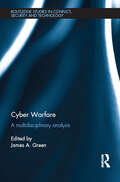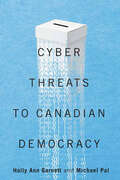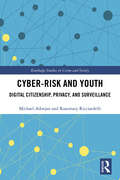- Table View
- List View
Cyber Criminology (Advanced Sciences and Technologies for Security Applications)
by Hamid JahankhaniThis book provides a comprehensive overview of the current and emerging challenges of cyber criminology, victimization and profiling. It is a compilation of the outcomes of the collaboration between researchers and practitioners in the cyber criminology field, IT law and security field.As Governments, corporations, security firms, and individuals look to tomorrow’s cyber security challenges, this book provides a reference point for experts and forward-thinking analysts at a time when the debate over how we plan for the cyber-security of the future has become a major concern. Many criminological perspectives define crime in terms of social, cultural and material characteristics, and view crimes as taking place at a specific geographic location. This definition has allowed crime to be characterised, and crime prevention, mapping and measurement methods to be tailored to specific target audiences. However, this characterisation cannot be carried over to cybercrime, because the environment in which such crime is committed cannot be pinpointed to a geographical location, or distinctive social or cultural groups. Due to the rapid changes in technology, cyber criminals’ behaviour has become dynamic, making it necessary to reclassify the typology being currently used. Essentially, cyber criminals’ behaviour is evolving over time as they learn from their actions and others’ experiences, and enhance their skills. The offender signature, which is a repetitive ritualistic behaviour that offenders often display at the crime scene, provides law enforcement agencies an appropriate profiling tool and offers investigators the opportunity to understand the motivations that perpetrate such crimes. This has helped researchers classify the type of perpetrator being sought. This book offers readers insights into the psychology of cyber criminals, and understanding and analysing their motives and the methodologies they adopt. With an understanding of these motives, researchers, governments and practitioners can take effective measures to tackle cybercrime and reduce victimization.
Cyber Criminology: Exploring Internet Crimes and Criminal Behavior
by K. JaishankarVictimization through the Internet is becoming more prevalent as cyber criminals have developed more effective ways to remain anonymous. And as more personal information than ever is stored on networked computers, even the occasional or non-user is at risk. A collection of contributions from worldwide experts and emerging researchers, Cyber Crimino
Cyber Forensics: A Field Manual for Collecting, Examining, and Preserving Evidence of Computer Crimes, Second Edition
by Albert Marcella Jr. Doug MenendezUpdating and expanding information on concealment techniques, new technologies, hardware, software, and relevant new legislation, this second edition details scope of cyber forensics to reveal and track legal and illegal activity. Designed as an introduction and overview to the field, the authors guide you step-by-step through the basics of investigation and introduce the tools and procedures required to legally seize and forensically evaluate a suspect machine. The book covers rules of evidence, chain of custody, standard operating procedures, and the manipulation of technology to conceal illegal activities and how cyber forensics can uncover them.
Cyber Forensics: Examining Emerging and Hybrid Technologies
by Albert J. MarcellaThreat actors, be they cyber criminals, terrorists, hacktivists or disgruntled employees, are employing sophisticated attack techniques and anti-forensics tools to cover their attacks and breach attempts. As emerging and hybrid technologies continue to influence daily business decisions, the proactive use of cyber forensics to better assess the risks that the exploitation of these technologies pose to enterprise-wide operations is rapidly becoming a strategic business objective. This book moves beyond the typical, technical approach to discussing cyber forensics processes and procedures. Instead, the authors examine how cyber forensics can be applied to identifying, collecting, and examining evidential data from emerging and hybrid technologies, while taking steps to proactively manage the influence and impact, as well as the policy and governance aspects of these technologies and their effect on business operations. A world-class team of cyber forensics researchers, investigators, practitioners and law enforcement professionals have come together to provide the reader with insights and recommendations into the proactive application of cyber forensic methodologies and procedures to both protect data and to identify digital evidence related to the misuse of these data. This book is an essential guide for both the technical and non-technical executive, manager, attorney, auditor, and general practitioner who is seeking an authoritative source on how cyber forensics may be applied to both evidential data collection and to proactively managing today’s and tomorrow’s emerging and hybrid technologies. The book will also serve as a primary or supplemental text in both under- and post-graduate academic programs addressing information, operational and emerging technologies, cyber forensics, networks, cloud computing and cybersecurity.
Cyber Fraud: Tactics, Techniques and Procedures
by Rick HowardWith millions lost each year, cyber crime has evolved from a minor nuisance to a major concern involving well-organized actors and highly sophisticated organizations. Arguably one of the most important challenges of the 21st century, with millions lost each year, cyber crime has evolved from a minor nuisance to a major concern involving well-organized actors and highly sophisticated organizations. This volume explores the state of threats present in the cyber fraud underground. It discusses phishing/pharming, trojans/toolkits, direct threats, and pump-and-dump scams. By examining the operations of the cyber criminal, the book provides perspective into the general incentives, risks, and behavioral patterns of the fraudsters. Armed with this information, organizations and individuals are better able to develop countermeasures and crafting tactics to disrupt the fraud underground and secure their systems.
Cyber Justice: Human Rights and Good Governance for the Internet (SpringerBriefs in Political Science)
by Anja MihrThis book introduces Cyber Justice as a viable approach for promoting good governance based on human rights norms in the internet. The author defines cyberspace as a borderless public space without common rules or government control mechanisms that protect and foster people's activities within that space. In light of the growing scope of communications and interactions in the internet, the author shows how human rights and governance regimes can be adapted to cyberspace in order to ensure more accountability, transparency and interaction among those who use the internet and those who manage and provide internet services. This book will be of interest for scholars and policymakers interested in establishing governance regimes for cyberspace that will enjoy the support and trust of all users.
Cyber Law and Ethics: Regulation of the Connected World
by Eric P. Robinson Mark GrabowskiA primer on legal issues relating to cyberspace, this textbook introduces business, policy and ethical considerations raised by our use of information technology. With a focus on the most significant issues impacting internet users and businesses in the United States of America, the book provides coverage of key topics such as social media, online privacy, artificial intelligence and cybercrime as well as emerging themes such as doxing, ransomware, revenge porn, data-mining, e-sports and fake news. The authors, experienced in journalism, technology and legal practice, provide readers with expert insights into the nuts and bolts of cyber law. Cyber Law and Ethics: Regulation of the Connected World provides a practical presentation of legal principles, and is essential reading for non-specialist students dealing with the intersection of the internet and the law.
Cyber Operations and International Law (Cambridge Studies in International and Comparative Law #146)
by François DelerueThis book offers a comprehensive analysis of the international law applicable to cyber operations, including a systematic examination of attribution, lawfulness and remedies. It demonstrates the importance of countermeasures as a form of remedies and also shows the limits of international law, highlighting its limits in resolving issues related to cyber operations. There are several situations in which international law leaves the victim State of cyber operations helpless. Two main streams of limits are identified. First, in the case of cyber operations conducted by non-state actors on the behalf of a State, new technologies offer various ways to coordinate cyber operations without a high level of organization. Second, the law of State responsibility offers a range of solutions to respond to cyber operations and seek reparation, but it does not provide an answer in every case and it cannot solve the problem related to technical capabilities of the victim.
Cyber Peace: Charting a Path Toward a Sustainable, Stable, and Secure Cyberspace
by Frédérick Douzet Scott J. Shackelford Christopher AnkersenThe international community is too often focused on responding to the latest cyber-attack instead of addressing the reality of pervasive and persistent cyber conflict. From ransomware against the city government of Baltimore to state-sponsored campaigns targeting electrical grids in Ukraine and the U.S., we seem to have relatively little bandwidth left over to ask what we can hope for in terms of 'peace' on the Internet, and how to get there. It's also important to identify the long-term implications for such pervasive cyber insecurity across the public and private sectors, and how they can be curtailed. This edited volume analyzes the history and evolution of cyber peace and reviews recent international efforts aimed at promoting it, providing recommendations for students, practitioners and policymakers seeking an understanding of the complexity of international law and international relations involved in cyber peace. This title is also available as Open Access on Cambridge Core.
Cyber Rights: Defending Free Speech in the Digital Age
by Mike GodwinLawyer and writer Mike Godwin has been at the forefront of the struggle to preserve freedom of speech on the Internet. In Cyber Rights he recounts the major cases and issues in which he was involved and offers his views on free speech and other constitutional rights in the digital age. Godwin shows how the law and the Constitution apply, or should apply, in cyberspace and defends the Net against those who would damage it for their own purposes. Godwin details events and phenomena that have shaped our understanding of rights in cyberspace--including early antihacker fears that colored law enforcement activities in the early 1990s, the struggle between the Church of Scientology and its critics on the Net, disputes about protecting copyrighted works on the Net, and what he calls "the great cyberporn panic." That panic, he shows, laid bare the plans of those hoping to use our children in an effort to impose a new censorship regime on what otherwise could be the most liberating communications medium the world has seen. Most important, Godwin shows how anyone--not just lawyers, journalists, policy makers, and the rich and well connected--can use the Net to hold media and political institutions accountable and to ensure that the truth is known.
Cyber Risks for Business Professionals
by Rupert KendrickRealise the benefits of Internet technologies, while ensuring your company is protected from the associated risks!An effective risk management strategy is vital to your company's survival Internet technologies have revolutionised the way that business is conducted. However, these innovations expose your business to various risks. Inadequate security can lead to the theft of customer data and, in the event of technological failure or a cyberattack, your business could lose its ability to function altogether. An effective risk management strategy is, therefore, vital to your company's survival. Understand the origins of cyber risks and develop suitable strategies for their management Cyber Risks for Business Professionals: A Management Guide is a general guide to the origins of cyber risks and to developing suitable strategies for their management. It provides a breakdown of the main risks involved and shows you how to manage them. Covering the relevant legislation on information security and data protection, the author combines his legal expertise with a solid, practical grasp of the latest developments in IT to offer a comprehensive overview of a highly complex subject. Expert guidance examining the operational and technological risks Drawing on interviews with experts from Clifford Chance, Capgemini and Morgan Stanley amongst others, the book examines the operational and technological risks alongside the legal and compliance issues. This book will be invaluable to lawyers and accountants, as well as to company directors and business professionals. Benefits to business include: * Understand and manage the technological risks This book looks at the security issues surrounding Cloud computing, and highlights the problems that have arisen as a result of the use of laptop computers and memory sticks for remote working. Implementing a risk management framework will offer reassurance to your existing customers and improve your chances of winning new business. * Familiarise yourself with the legal issues You need to be aware of the laws that govern your activities when you do business online. The author offers you a guide to the most important aspects of IT law, and outlines the implications of recent legislation. The author also looks at the compliance requirements of PCI DSS (the Payment Card Industry Data Security Standard). * Control employee use of Web 2. 0 technologies While sites such as Facebook and LinkedIn help people to develop business contacts, employee misuse of social networking sites also causes problems, ranging from damage to the company's reputation to breaches of commercial confidentiality. This book offers advice on the right policy to adopt to ensure your staff use Web 2. 0 technologies responsibly. * Use technology to address the risks This book introduces you to IT solutions that you can deploy to improve your information security, such as encryption and digital watermarking. It also looks at how you can monitor and control e-mail to prevent the leaking of sensitive information.
Cyber Security Cryptography and Machine Learning: Third International Symposium, CSCML 2019, Beer-Sheva, Israel, June 27–28, 2019, Proceedings (Lecture Notes in Computer Science #11527)
by Moti Yung Shlomi Dolev Sachin Lodha Danny HendlerThis book constitutes the refereed proceedings of the Third International Symposium on Cyber Security Cryptography and Machine Learning, CSCML 2019, held in Beer-Sheva, Israel, in June 2019.The 18 full and 10 short papers presented in this volume were carefully reviewed and selected from 36 submissions. They deal with the theory, design, analysis, implementation, or application of cyber security, cryptography and machine learning systems and networks, and conceptually innovative topics in these research areas.
Cyber Security and Digital Forensics: Select Proceedings of the International Conference, ReDCySec 2023 (Lecture Notes in Networks and Systems #896)
by Usha Batra Nihar Ranjan Roy Sudeep TanwarThe book contains peer-reviewed papers from the International Conference on Recent Developments in Cyber Security organized by the Center for Cyber Security and Cryptology at Sharda University in June 2023. This volume focuses on privacy and secrecy of information, cryptography, applications and analysis, cyber threat intelligence and mitigation, cyber-physical systems, cyber threat intelligence, quantum cryptography and blockchain technologies and their application, etc. This book is a unique collection of chapters from different areas with a common theme and will be immensely useful to academic researchers and practitioners in the industry.
Cyber Security, Artificial Intelligence, Data Protection & the Law
by Robert Walters Marko NovakThis book provides a comparison and practical guide of the data protection laws of Canada, China (Hong Kong, Macau, Taiwan), Laos, Philippines, South Korea, United States and Vietnam. The book builds on the first book Data Protection Law. A Comparative Analysis of Asia-Pacific and European Approaches, Robert Walters, Leon Trakman, Bruno Zeller. As the world comes to terms with Artificial Intelligence (AI), which now pervades the daily lives of everyone. For instance, our smart or Iphone, and smart home technology (robots, televisions, fridges and toys) access our personal data at an unprecedented level. Therefore, the security of that data is increasingly more vulnerable and can be compromised. This book examines the interface of cyber security, AI and data protection. It highlights and recommends that regulators and governments need to undertake wider research and law reform to ensure the most vulnerable in the community have their personal data protected adequately, while balancing the future benefits of the digital economy.
Cyber Security: 19th China Annual Conference, CNCERT 2022, Beijing, China, August 16–17, 2022, Revised Selected Papers (Communications in Computer and Information Science #1699)
by Wei Lu Chao Li Weiping Wen Hanbing Yan Yuqing ZhangThis open access book constitutes the refereed proceedings of the 18th China Annual Conference on Cyber Security, CNCERT 2022, held in Beijing, China, in August 2022. The 17 papers presented were carefully reviewed and selected from 64 submissions. The papers are organized according to the following topical sections: data security; anomaly detection; cryptocurrency; information security; vulnerabilities; mobile internet; threat intelligence; text recognition.
Cyber Security: Ein Einblick für Wirtschaftswissenschaftler (essentials)
by Sebastian KlipperIn diesem Buch erfahren Wirtschaftswissenschaftler, wie Firmen nach Hackerangriffen vom Markt verschwinden und wie Hacker Aktienkurse beeinflussen können. Lernen Sie, wie Homo oeconomicus beim Thema Cyber Security zum Homo carens securitate wird und wie es gelingt, mithilfe der wirtschaftswissenschaftlichen ,,Brille" (oder: Perspektive/Sicht) ganz neue Lösungsansätze und Sichtweisen im Kampf gegen Wirtschaftsspione, Hacker und Cyber-Kriminelle zu erkennen. Cyber Security bzw. IT-Sicherheit ist ein Zukunftsthema, an dem kaum jemand vorbeikommt. Dieses Buch beschreibt anhand aktueller Vorfälle - ohne technisches Grundwissen vorauszusetzen -, was Ökonomen wissen müssen, um sich am Gespräch über eines der wichtigsten Zukunftsthemen unserer Zeit beteiligen zu können.
Cyber Situational Awareness in Public-Private-Partnerships: Organisationsübergreifende Cyber-Sicherheitsvorfälle effektiv bewältigen
by Florian Skopik Maria Leitner Tímea PáhiDigitale Dienste werden für unsere Gesellschaft immer wichtiger, daher gelangen sie auch stärker ins Visier von Wirtschaftskriminellen, Spionen, Terroristen oder staatsfeindlichen Gruppierungen. Wie schützen sich Unternehmen und Staaten vor solchen Cyber-Attacken? Ein wichtiger Grundstein ist die Schaffung von Behörden, wie sie die EU-Richtlinie über Maßnahmen zur Gewährleistung eines hohen gemeinsamen Sicherheitsniveaus von Netz- und Informationssystemen (NIS) vorsieht. Das Buch zeigt, wie sich die Zusammenarbeit von Unternehmen mit diesen NIS-Behörden gestaltet mit dem gemeinsamen Ziel, Cyber-Sicherheit zu etablieren und zu gewährleisten. Darüber hinaus legen die Autoren dar, wie sich die NIS-Richtlinie und die im Mai 2018 in Kraft getretene EU-Datenschutz-Grundverordnung (DSGVO) auf Security-Prozesse in Unternehmen auswirken können. Das Buch verknüpft technische, organisatorische und rechtliche Aspekte der Zusammenarbeit und spiegelt damit die Komplexität des Themas wider. Zugleich liefert es zahlreiche Vorschläge zur Umsetzung der EU-Richtlinie. Im Mittelpunkt steht dabei das Konzept der „Cyber Situational Awareness“ – das bewusste Erfassen der aktuellen Lage – und damit ein Instrument, mit dem sich die Reaktionsfähigkeit bei Cyber-Angriffen wesentlich erhöhen lässt. Folgende Themen werden erläutert: • Aufbau und Nutzung von Cyber Situational Awareness • Erstellung von Cyber-Lagebildern auf nationaler Ebene • Informations- und Datenquellen für Cyber-Lagebilder• Informationsaustausch zwischen Cyber-Lagezentren und Stakeholdern • Informations- und Meldepflichten von Unternehmen• Planspiel zur Bildung und Evaluierung von Cyber Situational Awareness
Cyber Sovereignty: International Security, Mass Communication, and the Future of the Internet (Global Power Shift)
by Lev ToporThe internet has become a battleground for global power struggles, with nations and even terrorist organizations wielding cyber-attacks to exert control. As the absence of binding international laws and norms leaves cyberspace largely unchecked, countries are seeking to establish their Sovereign Cyber Domains (SCD) - tightly controlled cyberspaces. In this illuminating monograph, the author explores how Russia, China, Iran, and others perceive the internet as a means for the United States and its allies to maintain global dominance and influence foreign audiences, driving their pursuit of strict regulations over domestic cyber affairs and mass communication. Yet, even the United States is now susceptible to foreign cyber operations, mainly foreign influence that undermines its domestic affairs. Even International Blocs like the European Union had expressed concerns about foreign influence and privacy rights abuses, leading to regulatory initiatives like the General Data Protection Regulation, Digital Services Act and the Digital Markets Act. As nations prioritize cybersecurity and sovereignty over free speech and convenience, the book predicts a future of increased regulation across all layers of the cyber domain, mirroring the historical emergence of the concept of sovereignty.Drawing on a combination of political science, international relations, and cyber domain practices, this monograph offers valuable insights for policymakers, practitioners, researchers, and students. By analyzing existing cyber sovereignty processes and predicting future trends, the book contributes to international relations theories, sheds light on the challenges of an unregulated cyber domain, and provides guidance for a secure and controlled digital future.
Cyber Sovereignty: The Future of Governance in Cyberspace
by Lucie KadlecováGovernments across the globe find themselves in an exploratory phase as they probe the limits of their sovereignty in the cyber domain. Cyberspace is a singular environment that is forcing states to adjust their behavior to fit a new arena beyond the four traditional domains (air, sea, space, and land) to which the classic understanding of state sovereignty applies. According to Lucie Kadlecová, governments must implement a more adaptive approach to keep up with rapid developments and innovations in cyberspace in order to truly retain their sovereignty. This requires understanding the concept of sovereignty in a more creative and flexible manner. Kadlecová argues that the existence of sovereignty in cyberspace is the latest remarkable stage in the evolution of this concept. Through a close study of the most advanced transatlantic cases of state sovereignty in cyberspace—the Netherlands, the US, Estonia, and Turkey—Cyber Sovereignty reveals how states have pursued new methods and tactics to fuel the distribution of authority and control in the cyber field, imaginatively combining modern technologies with legal frameworks. In times of booming competition over cyber governance between democracies and authoritarian regimes worldwide, cyber sovereignty is a major topic of interest, and concern, for the international community.
Cyber Victimology: Decoding Cyber-Crime Victimisation
by Debarati HalderCyber Victimology provides a global socio-legal-victimological perspective on victimisation online, written in clear, non-technical terms, and presents practical solutions for the problem. Halder qualitatively analyzes the contemporary dimensions of cyber-crime victimisation, aiming to fill the gap in the existing literature on this topic. A literature review, along with case studies, allows the author to analyze the current situation concerning cyber-crime victimisation. A profile of victims of cyber-crime has been developed based on the characteristics of different groups of victims. As well, new policy guidelines on the basis of UN documents on cybercrimes and victim justice are proposed to prevent such victimisation and to explore avenues for restitution of justice for cases of cyber-crime victimisation. This book shows how the effects of cyber victimisation in one sector can affect others. This book also examines why perpetrators choose to attack their victim/s in specific ways, which then have a ripple effect, creating greater harm to other members of society in unexpected ways. This book is suitable for use as a textbook in cyber victimology courses and will also be of great interest to policy makers and activists working in this area.
Cyber Warfare and the Laws of War
by Heather Harrison DinnissThe information revolution has transformed both modern societies and the way in which they conduct warfare. Cyber Warfare and the Laws of War analyses the status of computer network attacks in international law and examines their treatment under the laws of armed conflict. The first part of the book deals with the resort to force by states and discusses the threshold issues of force and armed attack by examining the permitted responses against such attacks. The second part offers a comprehensive analysis of the applicability of international humanitarian law to computer network attacks. By examining the legal framework regulating these attacks, Heather Harrison Dinniss addresses the issues associated with this method of attack in terms of the current law and explores the underlying debates which are shaping the modern laws applicable in armed conflict.
Cyber Warfare: A Multidisciplinary Analysis (Routledge Studies in Conflict, Security and Technology)
by James GreenThis book is a multi-disciplinary analysis of cyber warfare, featuring contributions by leading experts from a mixture of academic and professional backgrounds. Cyber warfare, meaning interstate cyber aggression, is an increasingly important emerging phenomenon in international relations, with state-orchestrated (or apparently state-orchestrated) computer network attacks occurring in Estonia (2007), Georgia (2008) and Iran (2010). This method of waging warfare – given its potential to, for example, make planes fall from the sky or cause nuclear power plants to melt down – has the capacity to be as devastating as any conventional means of conducting armed conflict. Every state in the world now has a cyber-defence programme and over 120 states also have a cyber-attack programme. While the amount of literature on cyber warfare is growing within disciplines, our understanding of the subject has been limited by a lack of cross-disciplinary engagement. In response, this book, drawn from the fields of computer science, military strategy, international law, political science and military ethics, provides a critical overview of cyber warfare for those approaching the topic from whatever angle. Chapters consider the emergence of the phenomena of cyber warfare in international affairs; what cyber-attacks are from a technological standpoint; the extent to which cyber-attacks can be attributed to state actors; the strategic value and danger posed by cyber conflict; the legal regulation of cyber-attacks, both as international uses of force and as part of an on-going armed conflict, and the ethical implications of cyber warfare. This book will be of great interest to students of cyber warfare, cyber security, military ethics, international law, security studies and IR in general.
Cyber-Development, Cyber-Democracy and Cyber-Defense: Challenges, Opportunities and Implications for Theory, Policy and Practice
by Elias G. Carayannis David F. J. Campbell Marios Panagiotis EfthymiopoulosIn this volume, contributors from academia, industry, and policy explore the inter-connections among economic development, socio-political democracy and defense and security in the context of a profound transformation, spurred by globalization and supported by the rapid development of information and communication technologies (ICT). This powerful combination of forces is changing the way we live and redefining the way companies conduct business and national governments pursue strategies of innovation, economic growth and diplomacy. Integrating theoretical frameworks, empirical research and case studies, the editors and contributors have organized the chapters into three major sections, focusing on cyber-development, cyber-democracy and cyber-defense. The authors define cyber-development as a set of tools, methodologies and practices that leverage ICT to catalyze and accelerate social, political and economic development, with an emphasis on making the transition to knowledge-based economies. One underlying understanding here is that knowledge, knowledge creation, knowledge production and knowledge application (innovation) behave as crucial drivers for enhancing democracy, society, and the economy. By promoting dissemination and sharing of knowledge, cyber-democracy allows a knowledge conversion of the local into the global (gloCal) and vice versa, resulting in a gloCal platform for communication and knowledge interaction and knowledge enhancement Meanwhile, technology-enabled interconnectivity increases the need to adopt new methods and actions for protection against existing threats and possible challenges to emerge in the future The final section contemplates themes of cyber-defense and security, as well as emerging theories and values, legal aspects and trans-continental links (NATO, international organizations and bilateral relations between states) Collectively, the authors present a unique collection of insights and perspectives on the challenges and opportunities inspired by connectivity.
Cyber-Threats to Canadian Democracy (McGill-Queen's/Brian Mulroney Institute of Government Studies in Leadership, Public Policy, and Governance)
by Holly Ann Garnett and Michael PalFrom the Cambridge Analytica scandal to overloaded internet voting servers to faulty voting machines, the growing relationship between democracy and technology has brought to light the challenges associated with integrating new digital tools into the electoral system. Canadian politics has also felt the impact of this migration online.This timely book presents the first comprehensive study of the various cyber-threats to election integrity across Canadian jurisdictions. Scrutinizing the events of the 2019 federal election, Cyber-Threats to Canadian Democracy examines how new technologies have affected the practice of electoral politics and what we can do to strengthen future Canadian elections. Through the disciplines of political science, law, computer science, engineering, communications, and others, chapters shed light on some of the most contentious issues around technology and electoral integrity. The contributors address current domestic and foreign threats to Canadian elections, evaluate the behaviour of actors ranging from political parties and interest groups to policymakers and election administrators, and assess emerging legal and regulatory responses while anticipating future challenges to the quality of elections in Canada and around the globe.Cyber-Threats to Canadian Democracy helps seed the study of digital technology’s security risks, providing insight into what reforms are needed and evaluating existing legal and policy frameworks in light of these threats.
Cyber-risk and Youth: Digital Citizenship, Privacy and Surveillance (Routledge Studies in Crime and Society)
by Michael Adorjan Rosemary RicciardelliCyber-risks are moving targets and societal responses to combat cyber-victimization are often met by the distrust of young people. Drawing on original research, this book explores how young people define, perceive, and experience cyber-risks, how they respond to both the messages they are receiving from society regarding their safety online, and the various strategies and practices employed by society in regulating their online access and activities. This book complements existing quantitative examinations of cyberbullying assessing its extent and frequency, but also aims to critique and extend knowledge of how cyber-risks such as cyberbullying are perceived and responded to. Following a discussion of their methodology and their experiences of conducting research with teens, the authors discuss the social network services that teens are using and what they find appealing about them, and address teens’ experiences with and views towards parental and school-based surveillance. The authors then turn directly to areas of concern expressed by their participants, such as relational aggression, cyberhacking, privacy, and privacy management, as well as sexting. The authors conclude by making recommendations for policy makers, educators and teens – not only by drawing from their own theoretical and sociological interpretations of their findings, but also from the responses and recommendations given by their participants about going online and tackling cyber-risk. One of the first texts to explore how young people respond to attempts to regulate online activity, this book will be key reading for those involved in research and study surrounding youth crime, cybercrime, youth culture, media and crime, and victimology – and will inform those interested in addressing youth safety online how to best approach what is often perceived as a sensitive and volatile social problem.
